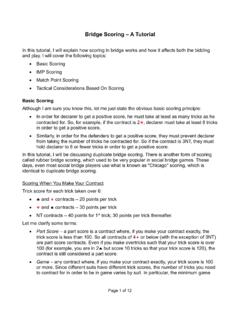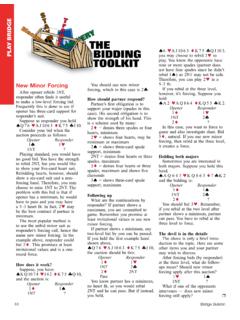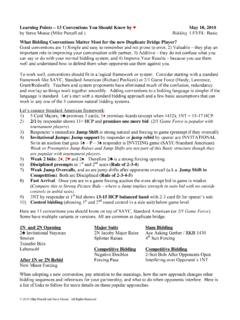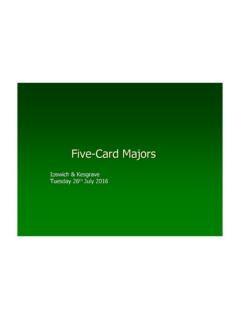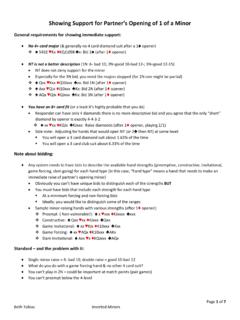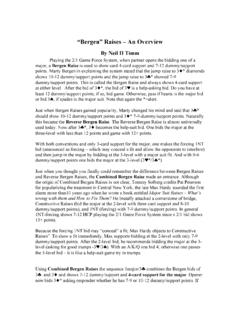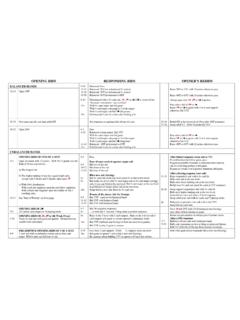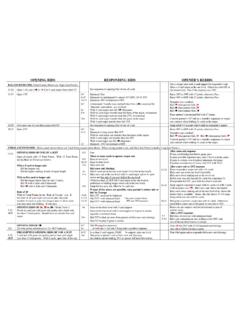Transcription of Introduction to Constructive Bidding - BridgeSights
1 Introduction to Constructive Bidding This is the first tutorial of a 5 lesson series on the Fundamentals of Constructive Bidding . Constructive Bidding is defined as auctions with no interference by the opponents. The purpose of these lessons is for students to learn the concepts behind Constructive Bidding . I have found that, although many students understand the (often complicated) rules about Bidding , they do not understand the reasoning behind these rules. By learning the fundamentals rather than just the rules, a student will be able to more intuitively and comfortably bid, without being confused by the many (sometimes conflicting) rules that may or may not apply.
2 Note that these lessons will not teach any particular system. It will simply teach the fundamentals upon which most Bidding systems are built. A. student should therefore be able to more comfortably play any of the popular systems. The series consists of 5 lessons;. Introduction to Constructive Bidding (this lesson). No Trump Auctions Major Suit Auctions Part 1. Major Suit Auctions Part 2. Minor Suit Auctions I consider this lesson the single most important of the series. If you learn and apply the principles presented here, your Bidding will improve, even if you do not take any of the subsequent lessons.
3 In this lesson, we will learn the basic principles of Bidding , regardless of whatever conventions or treatments you play. If you understand these principles, you will become a very good bidder, even if you play a very simple Bidding system. In fact, most very good money bridge players use a very natural style of Bidding , following these principles and using very few, if any, conventions. As one rubber bridge player once remarked to me after I watched him demolish a pretty good duplicate bridge partnership using his very simple Bidding style, "Match points (tournament bridge) is an interesting game, but it bears little resemblance to bridge".
4 Bidding Objectives Non-slam auctions have only 2 simple objectives: 1. Bid game if possible, otherwise stay as low as you can. 2. Find a good strain (trump suit or NT). You may have learned all these complicated Bidding rules, but their only purpose is to help you fulfill these simple objectives. In this lesson, I will teach you how to meet the first objective, determining if you should bid game. The subsequent lessons are related to meeting the second objective, finding a good strain. Determining If You Should Bid Game In all of these lessons, I will assume the reader uses basic hand evaluation techniques.
5 That is, he or she uses the standard 4-3-2-1 method for counting HCP and makes small adjustments for either shortness or length. I now teach, and prefer, the more accurate Bergen methodology, but, because it is not familiar to everyone, I will not use it in these lessons. Page 1 of 6. As opening bidder, your hand falls in one of three categories: 1. minimum (12-14 points). 2. medium (15-17 points). 3. maximum (18+ points). Similarly, as responder, your hand falls in one of three categories: 1. minimum (6-8 points). 2. medium (9-11 points).
6 3. maximum (12+ points). Remember, game requires that the combined partnership assets be at least 25 points. Therefore, the following table summarizes how the partnership can tell whether or not they have enough points to bid game: Opener Responder Minimum Medium Maximum Minimum No No Yes Medium No Yes Yes Maximum Yes Yes Yes During the auction, both partners should always be thinking about whether it is still possible to bid game. For example, if your partner opens and you, as responder, have a maximum (12+) hand, you should bid game.
7 Similarly, if you open with a maximum (18+) and get any response from partner, you should bid game. The Captain (Men, in particular, should pay special attention to this section because we will find it emotionally difficult to follw these principles!). Although the Bidding is a co-operative effort, one of the partners is considered the "captain" of the hand. The other partner is considered the subordinate (men, substitute "peon" or even "slave" so you get the point). The captain is in charge of deciding the final contract.
8 This is accomplished by asking the subordinate to further describe their hand and, perhaps, giving a choice of contracts. The subordinate simply answers the captain's questions. This next sentence is very important. On almost all hands, THE RESPONDER IS THE CAPTAIN OF THE. HAND. So (men), once you open the hand, you are relegated to being the subordinate. Similarly (ladies), you as responder are the captain and in charge of the auction. The Captain's Tools The main difficulty for the captain is to communicate to the subordinate when to keep Bidding and when to stop.
9 The main tool to accomplish this is the "new suit forcing " principle. If the responder bids a new suit, the opener is obligated to make another bid. Opener, if your partner introduces a new suit, YOU MAY NOT. PASS. Some advanced partnerships even play a convention called "fourth suit forcing ". If 3 suits have been bid, and responder bids the fourth suit, which may be artificial, the partnership is committed to bid game. Page 2 of 6. The other forcing bid is for responder to jump ( 1 -1 -2 -3 ). This should be avoided, if possible, in favor of new suit forcing , which leaves more room for further Bidding .
10 In fact, in those partnerships that play the fourth suit forcing convention, a jump rebid by responder is not forcing . The Subordinate's Tools The subordinate is responsible for describing both the strength ( minimum, medium, maximum) and suits. In this lesson, we will concentrate on how to describe strength. Minimum hands are described by making the cheapest bid possible in the strain opener wishes to bid ( 1 -1 -2 ). Maximum hands are described by jump shifting, Bidding one level higher than necessary in a new suit ( 1 -1 -3 ).
